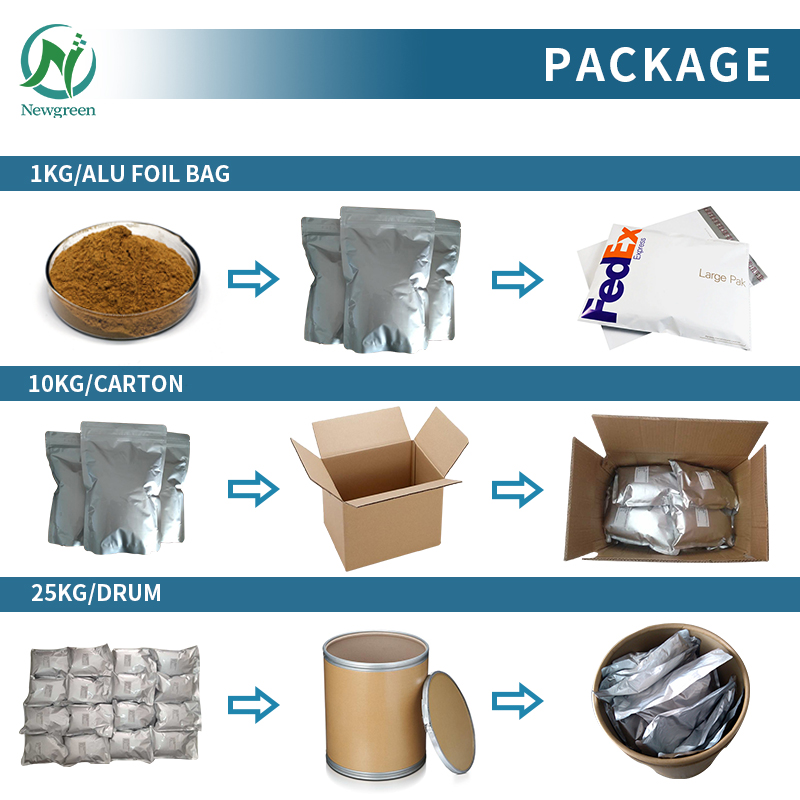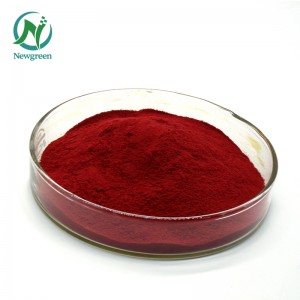L-Glutamic Acid Newgreen Supply Food Grade Amino Acids L Glutamic Acid Powder

Product Description
L-glutamic acid is an acidic amino acid. The molecule contains two carboxyl groups and is chemically named α-aminoglutaric acid, L-glutamic acid is a vital amino acid with significant roles in neurotransmission, metabolism, and nutrition.
Dietary Sources
L-glutamic acid is found in various foods, particularly those high in protein. Common sources include:
Meat
Fish
Eggs
Dairy products
Certain vegetables (like tomatoes and mushrooms)
COA
| Items | Specifications | Results |
| Appearance | White crystals or crystalline powder | Conform |
| Identification (IR) | Concordant with the reference spectrum | Conform |
| Assay(L-Glutamic Acid) | 98.0% to 101.5% | 99.21% |
| PH | 5.5~7.0 | 5.8 |
| Specific rotation | +14.9°~+17.3° | +15.4° |
| Chlorides | ≤0.05% | <0.05% |
| Sulfates | ≤0.03% | <0.03% |
| Heavy metals | ≤15ppm | <15ppm |
| Loss on drying | ≤0.20% | 0.11% |
| Residue on ignition | ≤0.40% | <0.01% |
| Chromatographic purity | Individual impurity≤0.5%
Total impurities≤2.0% |
Conform |
| Conclusion
|
It is conformed with the standard.
|
|
| Storage | Store in cool & dry place not freeze, keep away from strong light and heat. | |
| Shelf life |
2 years when properly stored |
|
Function
1. Neurotransmission
Excitatory neurotransmitter: L-glutamic acid is the most important excitatory neurotransmitter in the central nervous system. It is involved in the transmission and processing of information and has an important impact on learning and memory.
2. Metabolic function
Energy Metabolism: L-glutamic acid can be converted into α-ketoglutarate and participate in the Krebs cycle to help cells produce energy.
Nitrogen Metabolism: It plays an important role in the synthesis and decomposition of amino acids and helps maintain nitrogen balance.
3. Immune system
Immune Modulation: L-glutamic acid may play a role in the immune response, helping to regulate immune system function.
4. Muscle recovery
Sports Nutrition: Some research suggests that L-glutamic acid may aid muscle recovery after exercise and reduce feelings of fatigue.
5. Mental health
Mood Regulation: Due to its role in neurotransmission, L-glutamic acid may have some impact on mood and mental health, and research is exploring its potential role in depression and anxiety disorders.
6. Food additives
Taste Enhancement: As a food additive, L-glutamic acid (usually in its sodium salt form, MSG) is widely used to enhance the umami flavor of foods.
Application
1. Food industry
MSG: The sodium salt of L-glutamic acid (MSG) is widely used as a food additive to enhance the umami taste of food. It is commonly found in seasonings, soups, canned foods and fast food.
2. Pharmaceutical field
Nutritional Supplement: As a dietary supplement, L-glutamic acid is used to support exercise recovery, increase energy levels, and improve muscle function.
Neuroprotection: Research is exploring its potential applications in neurodegenerative diseases such as Alzheimer’s and Parkinson’s disease.
3. Cosmetics
Skin Care: L-glutamic acid is used in some skin care products to help improve skin condition due to its moisturizing and antioxidant properties.
4. Animal feed
Feed Additive: Adding L-glutamic acid to animal feed can improve animal growth performance and feed conversion rate.
5. Biotechnology
Cell Culture: In cell culture media, L-glutamic acid, as one of the amino acid components, supports the growth and reproduction of cells.
6. Research areas
Basic Research: In neuroscience and biochemistry research, L-glutamic acid is used as an important tool for studying neurotransmission and metabolic pathways.
Related Products

Package & Delivery



















